Show notes coming soon.
The post Pop the Bubble! appeared first on The Wood Whisperer.
from The Wood Whisperer https://ift.tt/3lhhIQN
via IFTTT
Show notes coming soon.
The post Pop the Bubble! appeared first on The Wood Whisperer.
As you might recall, my assistant Jon has some cool design ideas such as the Artsy Fan C-Table we made last year. His next idea was for a daybed featuring a stylized Denver skyline headboard. Since the bed is for his young daughter, one of the design priorities was to make sure the headboard could be re-used in the future for a larger king-size bed, and we were able to accomplish that.
The primary joinery for the bed is Dominos along with Domino DF500 Knock-Down Hardware.
The finish we used was Walrus Oil. Jon wanted a finish that was easy to apply, easy to repair, and most importantly safe for his daughter. It’s hard to think of a finish that fits that description better than Walrus Oil. Walrus Oil has a wide range of products but the one we used was their Furniture Butter. It’s made from plant-based polymerized oils and hard waxes and applies with nothing more than a rag.
If you’d like to try some Walrus Oil products for yourself you can use the coupon code Marc at checkout for 20% OFF until August 31st.
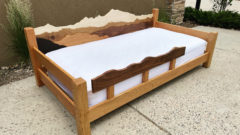
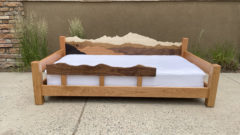

The post Denver Skyline Daybed | Converts to King appeared first on The Wood Whisperer.
00:00:42 – Welcome back to the Wood Whisperer Live Show
00:01:03 – Thank you to all who watch!
00:01:48 – Thank you to our Patreon and YouTube members!
00:02:35 – New video Friday!
00:06:20 – New mugs are in stock!
00:07:35 – Guild scholarship announcement
00:08:34 – Sign up for the Wood Whisperer newsletter
00:09:20 – Powermatic sweepstakes!
00:10:09 – How can I secure something like [picture] to the wall?
00:12:25 – What is the dinosaur comic in the background?
00:13:19 – Will this cutting board [picture included] explode with movement?
00:16:40 – Can you make your own furniture finish sous-vide style?
00:19:43 – Can I put a film finish over a waxed surface?
00:21:30 – Can you darken cherry plywood?
00:24:53 – Can you list estimated project time completion on guild projects?
00:26:22 – What’s the BAN hammer?
00:27:07 – Are square or round dog holes better?
00:28:28 – Do you have any recommendations for a drum sander?
00:30:17 – How can I fix turned, laminated legs that are splitting?
00:33:09 – How long can you leave finish in a spray gun before it’s an issue?
00:34:40 – Are you ever going to produce CNC content?
00:36:36 – Where do you buy your screws?
00:37:30 – Are guild projects good for brand new woodworkers?
00:40:00 – Are there any new techniques or tools that you’re excited about?
00:41:54 – Any strategies for complicated glue-ups?
00:43:30 – Do you ever get analysis paralysis at certain points of projects?
00:45:03 – How can you use the whole bottle of CA glue?
00:46:25 – How can I keep my brick-sided shop cooler?
00:47:37 – Can I add water if my Titebond III is starting to get thick?
00:48:13 – What do you do for your shop lighting?
00:52:17 – Why do I get a white spot when I put a hot plate on it?
00:57:10 – Mug giveaway! Congratulations!
The post Hang On, I’m Making a Thumbnail | TWW Live appeared first on The Wood Whisperer.
CA (cyanoacrylate) glue is a handy thing to have in the shop. It dries fast, comes in several viscosities, and can solve a lot of problems for the woodworker. Oddly enough, the thing I use CA glue for the least is gluing together joinery, mostly because a traditional wood glue is easier to use, works better, is safer and is less expensive. But it’s still worth having a bottle or two around the shop.
Here are just a few of the things you can do with CA Glue and the viscosities I recommend. I’ll spoil the ending: I think you’re best off buying two: Medium and either Thick or Gel
The post CA Glue – The Woodworking Problem Solver appeared first on The Wood Whisperer.
My wife Nicole loves blankets and quilts and we often have trouble finding places to store them. Many of the quilts were made by Nicole so they’re actually something we’d like to be on display. So I went on the hunt for a cool quilt rack design to use as a starting point and quickly came up empty. Most quilt racks are more traditional in their styling and I wanted to do something different. That’s when I remembered an older project made by my good buddy David Marks on Woodworks: the Contemporary Magazine Rack. I though David’s design, if cut in half, would be a really cooling looking and elegant way to store a few quilts. So big thanks to David for letting me riff on his design and I highly recommend you go over to David’s site and spend $5 on that particular episode of Woodworks.
This is a fun and challenging project featuring bent lamination using a vacuum press, lots of mortise and tenon joinery, and modified half-lap joinery. If you’d like to see a more detailed presentation, we offer plans and a full video course on this project in the Wood Whisperer Guild.
And here are a few photos so you can see the Bent Lamination Quilt Rack in detail.
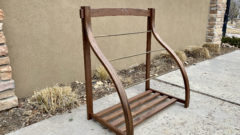
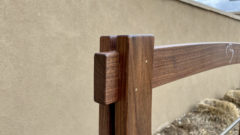

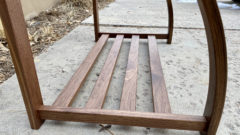
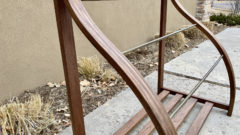
The post Not Your Grandma’s Quilt Rack | Bent Lamination appeared first on The Wood Whisperer.
Show notes coming soon.
The post Save the Domino! – TWW Live appeared first on The Wood Whisperer.
Drill bits are not all created equal and some bits won’t even find their way onto your radar until you’re neck deep in the craft. If you’re new to woodworking, this video might save you some time, money, and frustration as I show you the bits you should buy and the ones you should avoid. Unfortunately, many bits that excel in the construction industry just won’t cut it for fine woodworking and that means you may not find the good stuff at the local hardware store. Let’s dig in!
The standard twist bit is what most people think of when they hear the word “drill bit.” They feature a conical tip that can be tricky to locate accurately. They also have a tendency to cause tearout on the way it and on the way out of the material. Brad point bits are the much better choice for the fine woodworker. The spurs on the end of the bit are able to cut the wood fibers cleanly so the bit often has much less tearout. It’s still a good idea to have a Twist Bit set on hand for general use but when it comes to furniture projects, I’m using brad point bits.

Twist and brad point bits only get so large, so at a certain point you’ll need to turn to a different style bit to make bigger holes. In construction, the spade bit is often used because it’s aggressive and hogs through softwoods like my son on a plate of pizza rolls. But if you use a spade bit on hardwoods you’ll not only have a bunch of tearout and an ugly hole, you also might find the drill jumping and bucking like an angry bull. Thankfully there’s a better way: forstner bits. Forstner bits are capable of making very clean holes with zero tearout and a nice flat bottom. I use them quite often for making counterbores and small recesses for hardware. There’s very little reason for a woodworker to have spade bits in their tool box.
All countersink bits are generally considered part of the furniture-building world but some are better than others. For years I struggled with a basic countersink that certainly worked, but it also left burn marks on the surface and clogged after every hole. A few years ago I came across a much better option in the Amana Countersink Bit. The bit is fully adjustable and features a rotating stop that won’t mar the surface. Furthermore, the design allows the chips to clear instead of clogging.
Stop beating around the bush. This is the countersink you want to buy: Amana Countersink Bit
The post Buy This, Not That | Drill Bits appeared first on The Wood Whisperer.
Show notes coming soon.
The post Verified! appeared first on The Wood Whisperer.
I started by woodworking career in 2004. Over that time I’ve had the good fortune of learning from some great woodworkers who were quite generous with their information. In spite of that, there were some things I just had to learn the hard way. With that in mind, here’s a list of 10 Things I Wish I Knew When I Started Woodworking that will hopefully save you some headaches, time, and money.
The post 10 Things I Wish I Knew When I Started Woodworking appeared first on The Wood Whisperer.